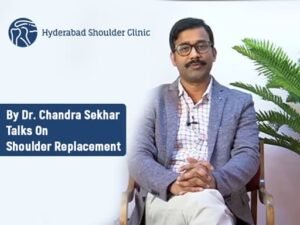A partially dislocated shoulder, also known as a subluxation, occurs when the head of the upper arm bone (humerus) is partially out of the shoulder socket (glenoid). This condition is less severe than a complete dislocation, where the humerus is entirely out of the socket. A subluxation may cause pain, weakness, and a feeling of instability in the shoulder. It can result from a direct injury, overuse, or weakness in the shoulder muscles and ligaments.
In some patients , this partial subluxation will become recurrent making the shoulder unstable in daily activities like reaching the shelf and throwing activities .
Treatment often includes rest, ice, physical therapy, and sometimes a brace to stabilize the shoulder for patients with a single episode . In patients who have recurrence, Arthroscopy ( Key Hole ) surgery may be necessary to repair or tighten the ligaments that support the shoulder.
What causes a partially dislocated shoulder?

A partially dislocated shoulder, also known as a subluxation, occurs when the head of the upper arm bone (humerus) is partially out of the socket (glenoid). This can happen due to a variety of reasons, including:
- Trauma or Injury: A direct blow to the shoulder, a fall on an outstretched arm, or a violent twist can force the shoulder partially out of its socket.
- Loose Joint Ligaments: Some people have looser ligaments that provide less stability to the joint. This condition, known as ligamentous laxity, can make them more prone to subluxation.
- Repetitive Strain: Athletes or individuals who engage in activities that involve repetitive overhead motions (like swimming, tennis, or baseball) can stretch out the shoulder ligaments over time, making the shoulder more susceptible to partial dislocations.
- Muscle Weakness: Weakness in the shoulder muscles, especially the rotator cuff muscles, can fail to keep the arm bone properly seated in the socket, leading to instability and potential subluxation.
- Genetic Factors: Some people may inherit a predisposition to joint problems, including looser ligaments, which can increase the risk of a partially dislocated shoulder.
- Previous Dislocations: Once a shoulder has been dislocated, it’s more likely to happen again. Previous injuries can stretch or tear the ligaments, compromising the stability of the shoulder.
Treatment typically involves rest, ice, and physical therapy to strengthen the muscles around the shoulder and improve its stability. In some cases, a brace or surgery might be necessary to correct the issue.
Who is most prone to partial shoulder dislocations?
Partial shoulder dislocations, also known as shoulder subluxations, can affect a wide range of individuals. However, they are most commonly seen in people who engage in activities that put excessive or repetitive strain on the shoulder. This includes athletes, particularly those involved in contact sports, overhead sports, or activities that require repetitive arm movements such as basketball, volleyball, swimming, and baseball. Additionally, individuals with loose ligaments or a history of shoulder injuries may have an increased risk of experiencing a partial shoulder dislocation. It’s also worth noting that younger adults and teenagers are more prone to this condition due to higher levels of physical activity and, in some cases, less developed musculature around the shoulder joint.
What are the Symptoms of a Partially dislocated shoulder?

A partially dislocated shoulder, also known as a subluxation, can present several symptoms, including:
- Pain: This is usually the immediate sensation felt when the shoulder experiences a subluxation. The pain can range from mild to severe and may increase with movement.
- Visible Deformity: In some cases, the shoulder might look out of place or deformed, although this might not be as evident as in a full dislocation.
- Limited Movement: There may be a reduced range of motion in the affected shoulder. Attempting to move the arm or shoulder could increase pain and discomfort.
- Weakness: The shoulder might feel weak, making it difficult to perform usual activities, especially those that require lifting or rotating the arm.
- Swelling and Tenderness: The area around the shoulder may swell and become tender to the touch due to the trauma of the partial dislocation.
- Numbness or Tingling: Some individuals might experience numbness or tingling sensations down the arm, indicating that nerves around the shoulder may be affected.
- A Feeling of Instability: The shoulder might feel loose or like it could pop out of place again, especially when trying to move or use the arm.
If you suspect a partially dislocated shoulder, it’s important to seek medical attention to prevent further injury and to ensure proper treatment and recovery.
A word from Hyderabad Shoulder Clinic about a partially dislocated shoulder
Right after the injury, rest your shoulder and use ice packs to reduce pain and swelling. You can take over-the-counter pain relievers for pain relief. We at Hyderabad Shoulder Clinic recommend using a sling to keep your shoulder from moving too much. After the initial healing, you may need physical therapy to strengthen your shoulder muscles and improve flexibility. As you recover, gradually start doing activities that don’t strain your shoulder too much. In some cases, surgery might be needed to repair the damaged ligaments in the shoulder.
For more information, please visit our website https://hyderabadshoulderclinic.com/ or contact us at +91 9959588389 or shoulderandsportsclinic@gmail.com.





